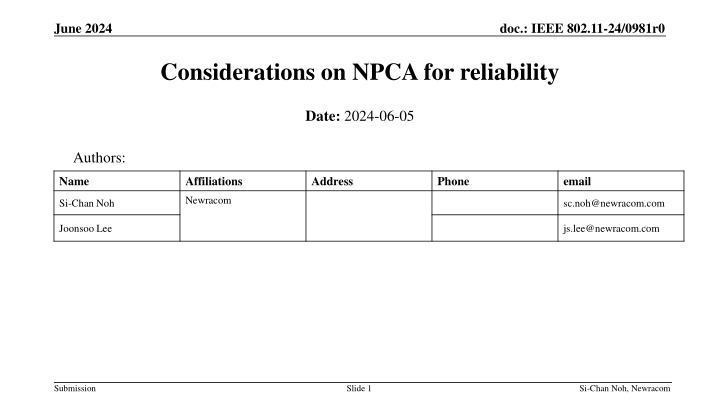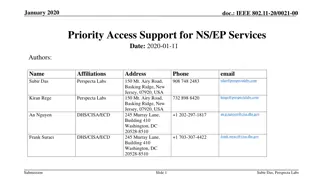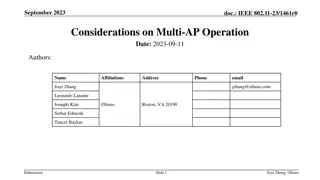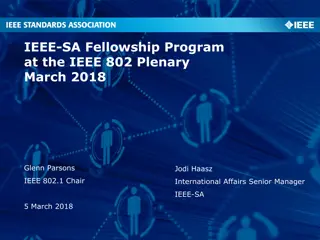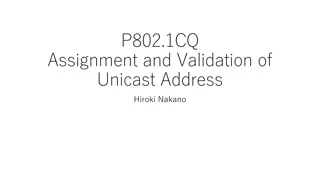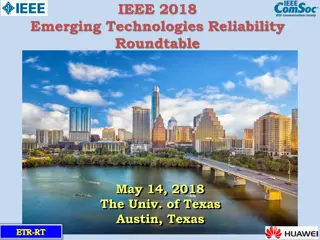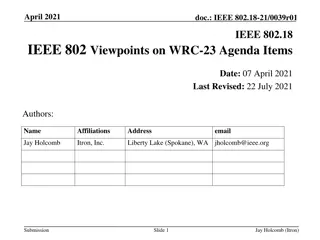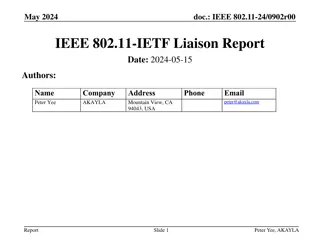Considerations on NPCA for Reliability in IEEE 802.11-24
In this document, considerations regarding the Non-Primary Channel Access (NPCA) for enhancing reliability in IEEE 802.11-24 are discussed. Topics cover frequent channel switching, potential approaches to prevent power drainage, and improve STA efficiency when operating in different channels. The document delves into scenarios of channel switching, criteria for NAV duration, and strategies to mitigate power consumption during NPCA operations.
Download Presentation

Please find below an Image/Link to download the presentation.
The content on the website is provided AS IS for your information and personal use only. It may not be sold, licensed, or shared on other websites without obtaining consent from the author.If you encounter any issues during the download, it is possible that the publisher has removed the file from their server.
You are allowed to download the files provided on this website for personal or commercial use, subject to the condition that they are used lawfully. All files are the property of their respective owners.
The content on the website is provided AS IS for your information and personal use only. It may not be sold, licensed, or shared on other websites without obtaining consent from the author.
E N D
Presentation Transcript
June 2024 doc.: IEEE 802.11-24/0981r0 Considerations on NPCA for reliability Date: 2024-06-05 Authors: Name Affiliations Address Phone email Newracom Si-Chan Noh sc.noh@newracom.com Joonsoo Lee js.lee@newracom.com Submission Slide 1 Si-Chan Noh, Newracom
June 2024 doc.: IEEE 802.11-24/0981r0 Introduction In 802.11bn, many contributions have been discussed to improve reliability, reduce latencies, increase throughput at different SINR levels, and reduce power consumption The Non-Primary Channel Access (NPCA) has been proposed and details are still under discussed to increase medium efficiency with increasing operating bandwidth [1-10] It can increase BW efficiency by allowing STAs to Tx/Rx in np-channels when the p-channel is BUSY This contribution discuss some considerations in the context of reliability on NPCA Frequent channel switching Identify BW of OBSS TXOP NPCA p-channel (i.e., NPCA back-off channel) is BUSY Submission Slide 2 Si-Chan Noh, Newracom
June 2024 doc.: IEEE 802.11-24/0981r0 Frequent channel switching on NPCA When a STA try to perform NPCA, frequent channel switching may lead to power drainage of STA and increase power consumption Prospective scenarios of frequent channel switching : STA do channel switch when p-channel is BUSY without any conditions When NAV duration of p-channel is too short, it may switch back to p-channel rapidly Attacker initiate an attack for the purpose of Power drainage of STAs which have capable of performing NPCA Improper cases that misleading the STAs to perform NPCA Submission Slide 3 Si-Chan Noh, Newracom
June 2024 doc.: IEEE 802.11-24/0981r0 Frequent channel switching on NPCA Potential approaches : Set the criteria of NAV duration Ex) When the STAs overhearing OBSS s (MU)-RTS/CTS, compared the estimated NAV duration with the criteria Estimated NAV duration of OBSS s signal >= criteria : move to np-channels to perform NPCA Estimated NAV duration of OBSS s signal < criteria : staying in p-channel It may prevent STAs frequent channel switching and lead to power saving STAs switch to the np-channels when overhearing signals from reliable OBSS AP s listings Ex) APs configured a Multi-AP coordination set can be one of the reliable OBSS AP s listing When the STAs overhear frames from reliable OBSS APs listing, it can move to np-channels When the STAs overhear frames from other APs not on the reliable OBSS AP s listing, staying in p-channel It may shrink the recognition of fake p-channel BUSY state due to attackers and prevent frequent channel switching which save STA s power consumption Submission Slide 4 Si-Chan Noh, Newracom
June 2024 doc.: IEEE 802.11-24/0981r0 Identify BW of OBSS TXOP on NPCA The STAs have different views of channel when switching to NPCA p-channel after a control frame exchange(e.g., MU-RTS/CTS) of an OBSS When the AP1 transmits control frame on 160MHz BW to STA1-1 and STA1-2 The STA1-1 transmits 80MHz CTS The STA1-2 transmits 160MHz CTS The view of channel status at AP2 and STA2 side Through the current baseline : The AP2 may not to perform NPCA due to the NPCA available channel is BUSY from the OBSS control frame exchange The STA2 may think it is possible to perform NPCA and switching channel due to only P80 is protected from the OBSS control frame exchange Potential approach : When the information of UL BW subfield in MU-RTS cover NPCA p-channel, do not perform NPCA Submission Slide 5 Si-Chan Noh, Newracom
June 2024 doc.: IEEE 802.11-24/0981r0 BUSY NPCA p-channel When the both p-channel and NPCA p-channel is BUSY due to OBSS signals, the STAs may not perform NPCA However, do not perform NPCA due to the NPCA p-channel is being BUSY may not align with the purpose of the NPCA which is discussed to enhance BW efficiency Potential approaches : Designate NPCA primary channel to minimize that the NPCA primary channel is covered by OBSS PPDU Regardless of how much the remaining BW is available for potential NPCA operation, do no perform NPCA when NPCA p-channel is BUSY due to the OBSS signals as like baseline How to designate NPCA primary channel to increase BW efficiency is TBD Submission Slide 6 Si-Chan Noh, Newracom
June 2024 doc.: IEEE 802.11-24/0981r0 Summary We discuss some considerations in terms of reliability when performing NPCA Frequent channel switching Identify BW of OBSS TXOP BUSY NPCA p-channel We need to consider how to allow reliable NPCA align with the goals of UHR Submission Si-Chan Noh, Newracom
June 2024 doc.: IEEE 802.11-24/0981r0 Reference [1] 23/0961r0, UHR Secondary Channel Access [2] 23/2005r1, Non-Primary Channel Access (NPCA) [3] 24/0495r0, Non-Primary Channel Access (NPCA) - Follow up [4] 24/70r2 Some details about non-primary channel access [5] 24/538r1 SP-based non-primary channel access [6] 23/0034r1, Non-Primary Channel Utilization [7] 23/1288r0, Non-Primary Channel Utilization Follow-up [8] 23/2023r1, Further discussion on Non-primary Channel Access [9] 23/0631r1, Secondary channel usage and secondary 20MHz channel backoff [10] 24/0496r1, Secondary Channel Usage Follow up Submission Si-Chan Noh, Newracom
